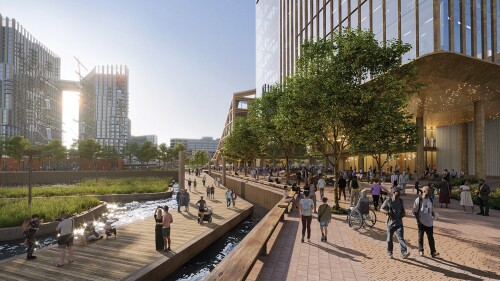Topics
Capital Markets and Finance
Three existing federal tax incentive programs that have been used frequently by developers received significant upgrades in this summer’s One Big Beautiful Bill Act. Low-income housing tax credits (LIHTCs) have long provided gap equity for affordable housing projects all over the country. New markets tax credits have been providing gap funding for a wide variety of economic development projects for more than 25 years. More recently, Opportunity Zones have steered investments in projects in low-income communities. The Big Beautiful Bill made improvements to each of these programs.
The National Retail Federation predicts a record-breaking 2025 holiday season, with U.S. sales for November and December projected to grow between 3.7 percent and 4.2 percent—pushing total holiday sales past $1 trillion for the first time. Yet there also are signs that consumers are nervous; that mood, plus accounting for inflation, could leave holiday spending relatively flat.
Canada’s real estate market remains deeply challenged: Although 2026 isn’t expected to deliver a rapid rebound, there is growing recognition that the next cycle will not mirror the last. Instead, the industry is entering a generational transition that demands new strategies, partners, and capital sources, as well as a fundamental modernization of how companies operate. A record-breaking crowd of more than 500 real estate leaders heard the “balanced but cautiously optimistic” 2026 outlook at the 21st Annual “ULI Toronto Trends in Real Estate” event at the Fairmont Royal York hotel.
Design & Planning
A recent project in Seattle—Africatown Plaza—demonstrates the alchemy of community collaboration and a development team’s commitment to creating a neighborhood that can thrive. Much can be learned from how the team prioritized people in the process to make a people-centered place.this process
Jeff Speck and I first met in 2004. I had just been elected mayor of Oklahoma City, and I was invited to Charleston for an event hosted by the Mayors’ Institute on City Design. Jeff was one of the design professionals lending expertise to mayors facing complex planning issues.
When I took office as mayor of Oklahoma City in 2004, my goals were similar to any other mayor’s: to improve our economy, raise our national profile, and protect our citizens. We had an intersection with safety concerns, and our planning department was pushing the idea to me and the City Council to install a traffic circle. At the time, traffic circles were new to this generation of Oklahoma City drivers, but we soon found out that they were cost-effective and most certainly safer.
Development and Construction
Infrastructure Ontario’s Provincial Affordable Housing Lands Program aims to create a mix of market-rate housing and permanent, sustainable, affordable housing on surplus land in greater Toronto. For its first effort, the agency chose Dream Asset Management, Kilmer Group, and Tricon Residential to develop a mixed-use community with 2,500 apartments on a former brownfield industrial site.
Steps from the Place de l’Europe in Paris, the French real estate company Covivio has recast a historic telephone exchange as its headquarters. Dubbed “L’Atelier,” the complex showcases the firm’s expertise, values, and culture; houses 250 Paris employees; and supports the company’s three business lines: office, hotel, and residential.
Since Microsoft established its headquarters in Redmond, Washington, in 1986, the company’s campus has grown from four buildings to more than 100. The East Campus Modernization Project is the latest addition: replacing several older structures with ones designed to meet the demands of the modern hybrid workplace—and embody the company’s commitment to both employee well-being and environmental stewardship.
Resilience and Sustainability
FORUM, a life sciences building developed by Lendlease, is the first purpose-built life sciences building in Boston Landing, a mixed-use district in the city’s Allston-Brighton neighborhood. Targeting LEED Platinum, the recently opened building employs numerous strategies that enable companies to meet stringent regulatory requirements, reduce their carbon footprint, and achieve net zero operations.
In late 2025, the ULI Randall Lewis Center for Sustainability in Real Estate convened a series of roundtables with sustainability leaders to explore the industry’s perspective on top global priorities in 2026. Roundtables consisted of members of the ULI Americas Sustainable Development Council, the ULI Asia Pacific Net Zero Council, the ULI Europe Sustainability Council, and sustainability-oriented committees of District Councils from ULI San Francisco, ULI New York, ULI Los Angeles, ULI Singapore, and ULI Philadelphia.
As 2025 draws to a close, the year’s most-read articles in Urban Land magazine reflect a pivotal moment in urban development. Themes reflected this year include resilience against climate-driven disasters, ambitious waterfront and downtown revitalizations, stabilizing construction economics, entertainment-anchored urban renewal, and innovative housing strategies. These stories also capture the industry’s focus on adaptive, inclusive, and forward-thinking land use.
Issues and Trends
The ULI Americas District Council Showcase of Excellence Awards celebrates achievement by District Councils as it relates to ULI’s mission and primary areas of focus, with particular attention given to programs that are both innovative in their format or approach to the subject matter and replicable at other District Councils. The ULI Americas region’s 58 District Councils submit the best of more than 2,000 programs held each year, with awards given, in each category, for District Councils with fewer than 600 members, and for District Councils with more than 600 members.
Singapore real estate veterans at a Women’s Leadership Initiative (WLI) event last month suggested that finding your own voice, challenging yourself, and not over-planning can help women in the industry to progress in interesting and worthwhile careers.
In October 2025, ULI convened the Water Wise Development Coalition to discuss the latest updates on water and land use policy and their implications for both the real estate industry and the country as a whole. The meeting brought together land use experts, real estate professionals, and public sector decision makers. Guest speakers included Kelly Connolly Kern, director of public affairs at the Alliance for Water Efficiency, and Lindsay Rogers, policy manager for municipal conservation at Western Resource Advocates.















